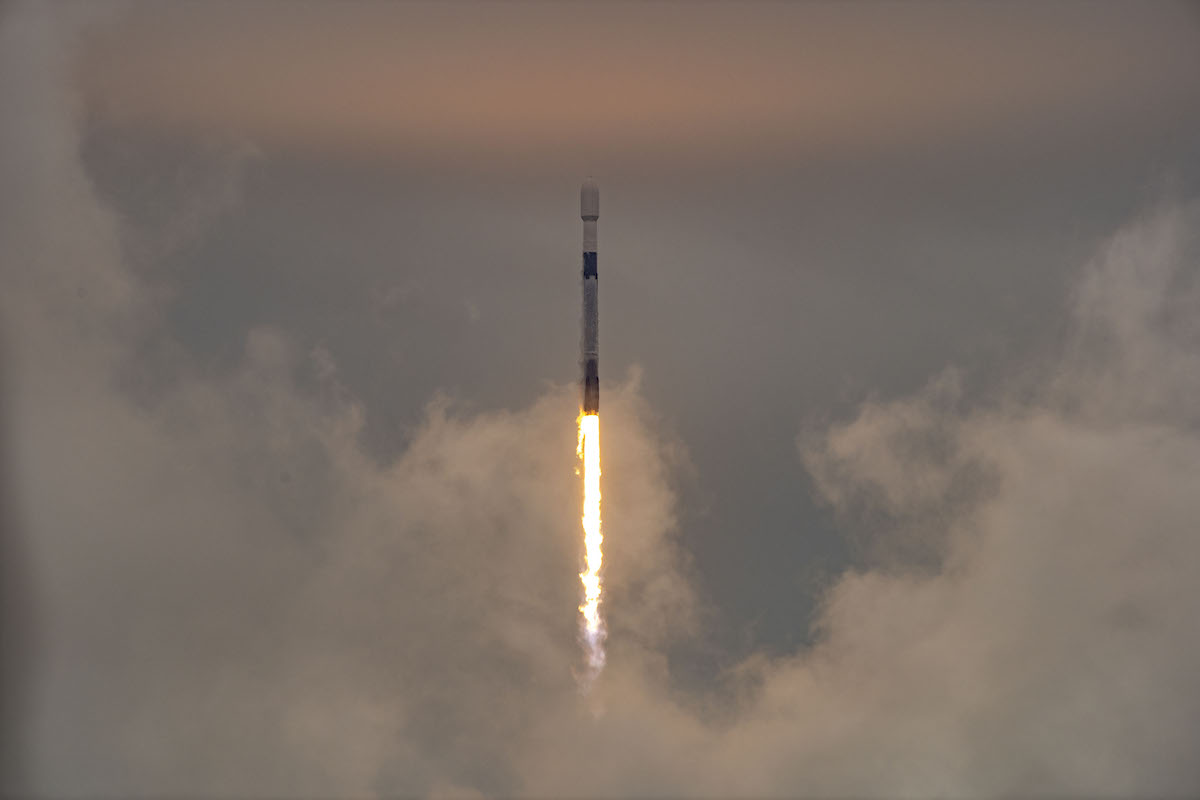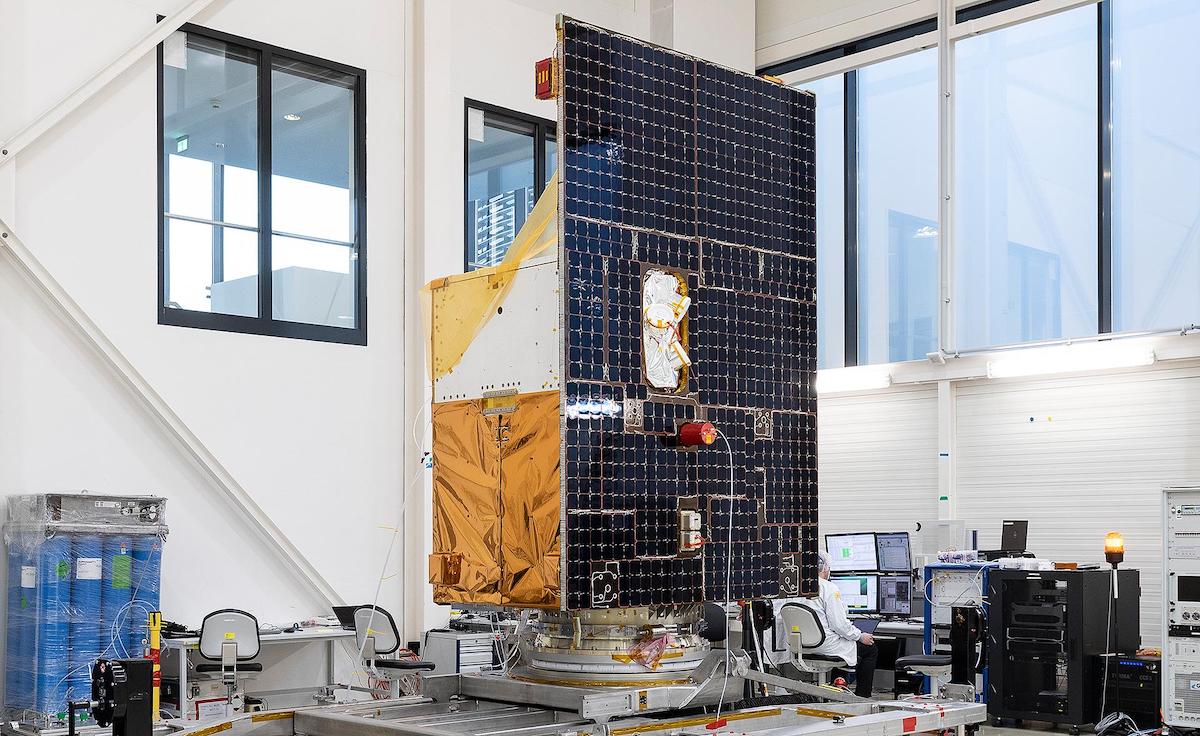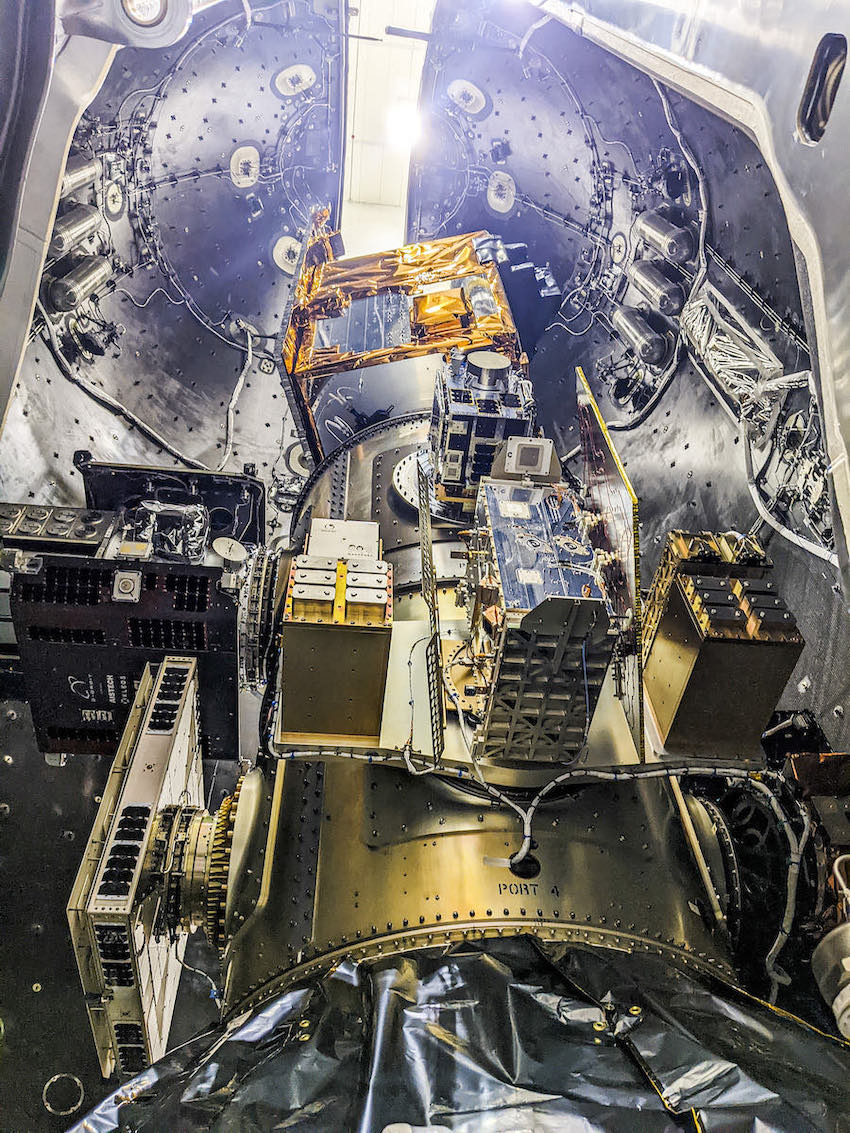
SpaceX launched a German environmental mapping satellite and 39 co-passenger spacecraft Friday, dodging thunderstorms near Cape Canaveral that threatened to keep the Falcon 9 rocket on the ground.
The rideshare mission, named Transporter 4, lifted off at 12:24:17 p.m. EDT (1624:17 GMT) from pad 40 at Cape Canaveral Space Force Station. Forecasters initially predicted just a 30% chance weather would be acceptable for launch Friday, but SpaceX proceeded with the countdown, and clouds lifted just enough to make it safe for the Falcon 9 to blast off from Florida’s Space Coast.
Nine Merlin 1D main engines throttled up to produce 1.7 million pounds of thrust, and hydraulic clamps opened to release the 229-foot-tall (70-meter) Falcon 9 rocket to begin a thundering climb into space. The launcher disappeared into low clouds a few seconds later, but cameras on-board the Falcon 9 relayed dazzling views of the rocket’s flight.
The first stage booster shut off its engines and separated from the Falcon 9 upper stage two-and-a-half minutes into the mission, beginning a descent toward SpaceX’s drone ship “Just Read the Instructions” in the Atlantic Ocean. The booster — number B1061 in SpaceX’s fleet — aced its seventh landing.
The second stage, meanwhile, propelled the mission’s 40 payloads to a polar orbit more than 400 miles (650 kilometers) above Earth. The upper stage engine steered the rocket from its initial path southeast from Cape Canaveral to a southerly track along Florida’s east coast, aiming for a polar orbit while avoiding a flyover of populated cities in South Florida.
The rocket released its first three payloads between 14 and 18 minutes after launch, including Germany’s EnMAP hyperspectral imaging satellite, the largest spacecraft on the Transporter 4 mission.
Liftoff of SpaceX’s Falcon 9 rocket from Cape Canaveral to begin the Transporter 4 mission, hauling a German environmental mapping satellite and 39 co-passengers into orbit. https://t.co/9VhFa0LK1L pic.twitter.com/1QWgHvJCLt
— Spaceflight Now (@SpaceflightNow) April 1, 2022
Two more burns by the upper stage engine, each lasting just one-to-two seconds, maneuvered the rocket to a lower orbit around 310 miles (500 kilometers) in altitude and adjusted its orbital inclination from 97.9 degrees to 97.4 degrees to the equator. That set the stage for release of the remaining payloads.
SpaceX confirmed all 40 spacecraft separated from the rocket about 86 minutes after liftoff, and officials declared mission success.
The mission marked the 146th flight of a Falcon 9 rocket since SpaceX’s workhorse launcher debuted in June 2010, and the 12th Falcon 9 launch so far this year.
It was SpaceX’s fourth dedicated rideshare launch carrying a flotilla of payloads for commercial startups and foreign governments. The 40 payloads on the Transporter 4 mission included spacecraft of various sizes, plus “non-deploying hosted payloads and an orbital transfer vehicle carrying spacecraft to be deployed at a later time,” SpaceX said.
A one-ton German observation satellite — named the Environmental Mapping and Analysis Program, or EnMAP — sat on top of a stack of microsatellites, CubeSats, and even smaller “picosats” for the ride into orbit Friday.
EnMAP was the biggest of the bunch, weighing roughly 2,160 pounds (980 kilograms) and about the size of a compact car, dwarfing its co-passengers on the Transporter 4 mission.
The EnMAP project is managed by DLR, the German space agency, which first approved the satellite for development in 2006. The launch of EnMAP has been delayed a decade due to technological and engineering problems, mainly associated with the satellite’s sophisticated imaging instrument.
The satellite will scan Earth’s surface with a telescope and dual spectrometers tuned to see sunlight reflected off the ground, lakes, rivers, and oceans in 242 colors.
“EnMAP is a satellite that acquires images of Earth,” said Sebastian Fischer, the mission manager at DLR. “However, an image is normally recorded in three different colors: red, green and blue. The unique thing about EnMAP is that it does not only concentrate on these three colors, but the light is split into very many, very small wavelength ranges.”
The extra detail can tell scientists, policymakers, businesses, farmers, and foresters about the state of the environment, giving insights about the health of vegetation and water pollution.
With EnMAP, “we have a separate image for each wavelength range, which we can then analyze,” Fischer said. “And we can detect, for example, if a plant does not have enough water, or if the plant is missing nutrients.”
The EnMAP spacecraft and its hyperspectral imaging instrument were built by the German space company OHB. Originally, the plan was to send EnMAP aloft on a dedicated flight on a smaller rocket, such as India’s PSLV or the European Vega launcher, Fischer said.
But SpaceX’s rideshare program offered EnMAP a ride to space at the right time.
Falcon 9 has shed its first stage booster and payload fairing, revealing the 40 Transporter 4 payloads to space for the first time. The second stage has ignited, and the first stage is coming back to Earth for a drone ship landing. https://t.co/9VhFa0LK1L pic.twitter.com/togsO4an3d
— Spaceflight Now (@SpaceflightNow) April 1, 2022
“In a moment where the launcher market is not too easy to get a quick launch ready for your mission, we were able to find with SpaceX a launch service that was fitting perfectly to our schedule, and that was one of the main reasons for the connection,” Fischer said.
None of the other rockets on the commercial launch market offered a flight that fit EnMAP’s schedule.
“We prefer to get it launched as soon as possible rather than delaying the program even further,” Fischer said in an interview with Spaceflight Now.
SpaceX announced its small satellite rideshare launch service in 2019. It launched the first Transporter mission on Jan. 24, 2021, with a record 143 satellites on a single rocket. The Transporter 2 mission on June 30, 2021, carried 88 payloads into orbit, and Transporter 3 launched Jan. 13 with 105 spacecraft.
The manifest for Transporter 4 was reduced to 40 spacecraft, but that was primarily due to EnMAP’s presence on the mission. The satellite was heavier than any of the satellites SpaceX has flown on any of the previous Transporter missions, and the Falcon 9 delivered EnMAP to an orbit higher than the the past rideshare launches.
SpaceX intends to launch as many as four dedicated ridehsare flights on Falcon 9 rockets this year, doubling the rate of Transporter launches from about one every six months to one every three-to-four months.
The next rideshare launch, Transporter 5, is scheduled for liftoff June 1 from Cape Canaveral. It was recently relocated from Vandenberg Space Force Base, California.
There’s high demand for the rideshare launch service. Several SpaceX customers have said the price for a slot on a Transporter mission is unmatched in the launch industry.
On its website, SpaceX says it charges customers as little as $1.1 million to launch a payload of 440 pounds (200 kilograms) on a dedicated rideshare flight to sun-synchronous orbit. The price is enabled by cost reductions from reusing Falcon 9 rocket hardware.
Earlier this month, SpaceX hiked its rideshare launch prices by 10%, from $1 million to $1.1 million for a 440-pound payloads, blaming “excessive levels of inflation.” The company raised its standard dedicated Falcon 9 launch price from $62 million to $67 million for the same reason.
Falcon 9 has landed! A seventh mission is in the books for SpaceX’s B1061 first stage booster after arriving on the deck of the drone ship between the Bahamas and Cuba. https://t.co/9VhFa0LK1L pic.twitter.com/7AvTB3vWSL
— Spaceflight Now (@SpaceflightNow) April 1, 2022
Fischer declined to disclose SpaceX’s launch price for EnMAP, but said the expense was included in the mission’s total budget of about 300 million euros ($330 million), which also includes five years of operations in orbit. EnMAP’s budget was originally set for 90 million euros.
The EnMAP spacecraft arrived at Cape Canaveral from Germany in late February aboard a Russian Ilyushin Il-76 cargo plane, touching down in Florida a few days before the U.S. government banned Russian aircraft from U.S. airspace after Russia’s invasion of Ukraine.
Engineers verified the spacecraft weathered its trans-Atlantic journey, then loaded EnMAP with hydrazine fuel in mid-March.
“It was a bit of a challenge to get EnMAP on a rideshare mission because it’s big satellite with a lot of stuff that we needed to do at the launch site to check all the functions of the satellite,” Fischer said. “But I have to say everything went very smooth. The whole launch campaign was not delayed by one day.”
SpaceX encapsulated EnMAP and its 39 co-passengers inside the Falcon 9 rocket’s payload fairing last week, then integrated the payload compartment with the rest of the launcher. Ground teams rolled the Falcon 9 from its hangar to pad 40 at Cape Canaveral Space Force Station, then raised the rocket vertical Thursday afternoon in preparation for Friday’s launch opportunity.
EnMAP was the first spacecraft to deploy from the Falcon 9 rocket in order to limit the structural loads on EnMAP during separation of the other satellites, according to Fischer.
German ground teams established contact with EnMap through a tracking station in Svalbard, Norway, about an hour after separating from the Falcon 9.
After two weeks of checkouts and activations, EnMAP’s instrument will be calibrated and commissioned before the satellite begins its operational mission in the September timeframe.
Capable of collecting spectra in visible and infrared light bands, EnMAP will see details of Earth’s surfaces invisible to the human eye, closing a gap in Earth observation missions, according to Walther Pelzer, head of DLR and a member of DLR’s executive board.

“We are then able to determine the fingerprints of different materials, or behavior of certain surfaces, especially natural surfaces, so agriculture and forests,” Fischer said.
The data could tell farmers where to irrigate or fertilize their crops, and identify the types of crops being grown in fields around the world, within boxes as small as 100 feet (30 meters).
“This information is obviously important in order to be able to secure the food situation in the future with an increasing world population,” Pelzer said.
The mission will also measure algae growth and pollution in inland and coastal waters.
EnMAP data will be released to scientists within a few days, and free of charge. The mission is not designed to continuously observe, but it can take data over the same region as often as every four days, using the spacecraft’s ability to point 30 degrees either side of its ground track.
Once EnMAP was off the Falcon 9, the rocket deployed two other payloads: a small spacecraft named LEO-1 for a U.S. company called Omnispace, and the 88-pound (40-kilogram) GNOMES 3 radio occultation atmospheric monitoring satellite for a Colorado-based company named PlanetiQ.
After moving to the lower orbit, the Falcon 9 released the rest of the Transporter payloads.
The other payloads included five spacecraft for Satellogic’s commercial Earth observation fleet, growing the Argentine company’s constellation to 22 satellites. One of the Satellogic “NewSat” satellites that launched on Transporter 4 is an upgraded spacecraft model with an improved camera and on-board computers.
There were three formation-flying spacecraft on the Transporter 4 launch for HawkEye 360, a U.S. company building a satellite constellation to detect and locate the source of terrestrial radio signals. HawkEye 360 says its RF monitoring satellites recently detected GPS interference in Ukraine as Russian military forces invaded the country.

Lynk Global, a Virginia-based company developing technology to connect standard mobile phones through satellites, launched its sixth spacecraft on the Transporter 4 mission, according Charles Miller, the company’s CEO. Named Lynk Tower 1, it’s the first satellite covered in Lynk Global’s application for commercial service with the Federal Communications Commission.
The company refers to its technology as akin to a cell tower in space, providing two-way connectivity for broadband, voice, and text messaging anywhere in the world. Lynk Tower 1 had a launch weight of about 132 pounds, or 60 kilograms, Miller told Spaceflight Now.
Other satellites on the Transporter 4 mission included MP42, a new design for a microsatellite platform developed by NanoAvionics in Lithuania. The BRO-7 CubeSat, about the size of a small briefcase, was launched for the French startup UnseenLabs, which is fielding a constellation of satellites for maritime surveillance.
The Norwegian Defense Research Establishment, a research arm of the Norwegian military, launched the ARCSAT six-unit CubeSat to demonstrate UHF tactical communications in the North Sea and the Arctic region.
The Transporter 4 mission also launched a CubeSat named BDSAT from the Czech Republic for a technology demonstration mission, the AlfaCrux educational and tech demo CubeSat from the University of Brasilia in Brazil, and a small satellite from the Indian remote sensing startup Pixxel named Shakuntala.
There were also 12 tiny “picosatellites” on the Transporter 4 mission for Swarm Technologies, a company owned by Space. Swarm is developing a low-data-rate satellite communications system. Each of the Swarm satellites is about the size of a slice of bread.
A satellite for the Italian company D-Orbit also deployed from the Falcon 9 rocket on the Transporter 4 mission. D-Orbit’s ION satellite carrier vehicle flew away from the Falcon 9 and release seven smaller spacecraft in the next few weeks.
Kleos is not a customer of D-Orbit. Kleos is a Spaceflight Inc. customer, and we partnered with D-Orbit to deploy them. We own the launch contract. It may seem like a nuance, but our legal team is really specific that we get that stated properly.
The payloads on D-Orbit’s carrier include four spacecraft from Kleos Space of Luxembourg. Kleos contracted with Spaceflight, a rideshare launch broker, on SpaceX’s Transporter 3 mission in January, but the satellites missed the launch.
Spaceflight partnered with D-Orbit to launch the Kleos satellites on Transporter 4. Kleos says its satellites can detect and geolocate radio frequency transmissions, providing intelligence on maritime activity for governments and commercial customers. The Kleos mission is similar to the three HawkEye 360 spacecraft that also flew on the Transporter 4 launch.
Three university-built CubeSats from Chile are also riding on D-Orbit’s satellite carrier module, and a payload that will remain attached to the ION vehicle carries small items from four clients of Upmosphere, an Italian startup offering accommodations for customers to place keepsakes and mementos into wooden boxes for a flight into orbit.
Email the author.
Follow Stephen Clark on Twitter: @StephenClark1.
